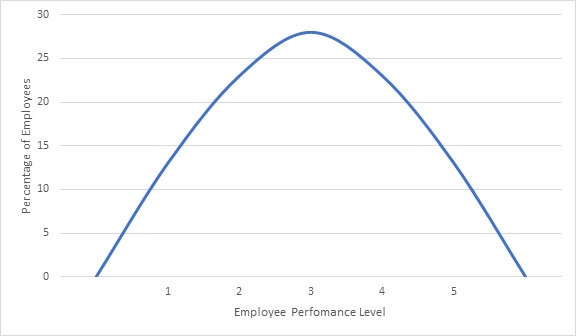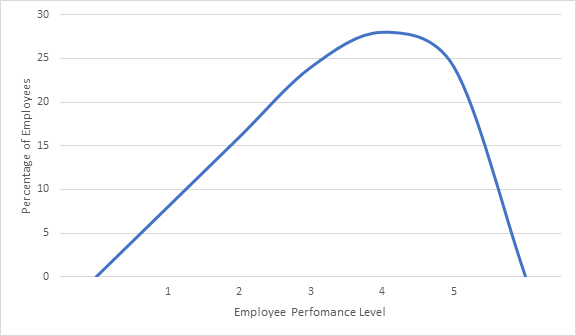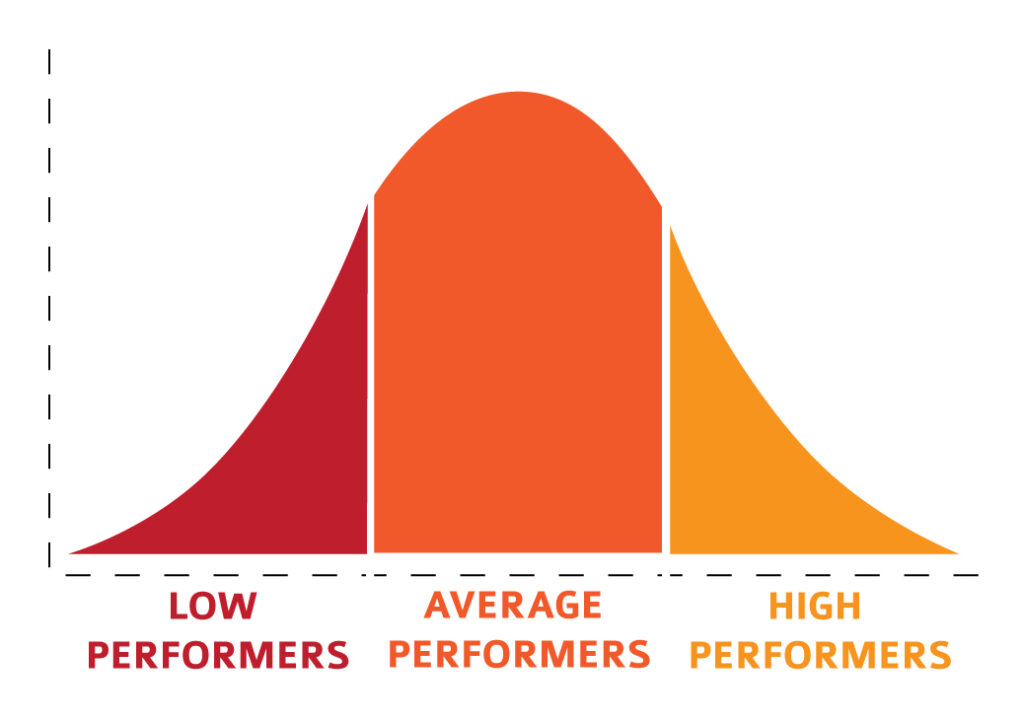Great companies are made of great people. It’s a simple fact that the companies with the best employees win. The real competition within industries is how to get and keep more great employees than your competitors.
Is it possible for all of your employees to be great? Of course not. Is it possible that they all be above average? Definitely!
And before you accuse us of being pessimistic, let’s look at the numbers. Below is standard bell curve graph. Assume that this graph represents a normal company. Employees are ranked 1 through 5, with 5 being your best performers and 1 being your poorest. A 5 is someone who can make a real difference at your organization, someone who is innovative, committed and engaged. A 1 is someone you could take or leave, someone who comes in late, does the bare minimum and leaves early.

Statistically, you can’t have all 5’s. The 1’s and the 5’s each represent a little less than 20% of the population. The majority of the employees are in the center. They are the 2’s, 3’s, and 4’s who represent over 60% of the count.
Below is what a great company’s employee distribution may look like. More of the employees are in the 3, 4, and 5 categories. You will notice that the majority of employees are still not 5’s though. The key here is to notice that though they’re not all 5’s, the vast majority of the team is above average.

As a leader at your organization your job is to move your team to the right. Away from the 1’s and towards the 5’s. The greatest opportunity for you to provide value is with the 60% of your team in the middle.
If you can shift the performance in of the 2’s, 3’s, and 4’s you can shift the performance of the whole company.
So how do you go about getting a higher proportion of great employees? How do you go about growing your teammates so that they are all above average?
By creating a culture that attracts, develops, and keeps GREAT employees.
First of all, you need to acknowledge that winners want to associate with other winners. Level 5 employees want to work in a high performance environment. They want to be challenged. They want feedback on and an opportunity to improve their performance. They want to know what is expected of them and how they measure up against those expectations.
Another key fact to acknowledge is that level 5 employees, and even those with level 5 potential, are already working somewhere. Unless they have self-selected out of a role, they are not unemployed. Remember, these are GREAT employees we’re talking about, you’re going to have to do more than just wait for them to come to you. You have to build a culture that naturally attracts their talent.
It is possible to build a culture that not only attracts more level 5 employees but that also helps develop level 5 employees out of your current staff. Here are 5 steps to creating a culture that attracts, develops, and keeps great employees.
Step 1: Role Clarity
See that the expectations of success for every role at your company are clearly defined and shared. This applies across the entire company. From the front line to the executive suite. Everyone should know what the expectations of success are for their individual role as well as every role in the company.
Step 2: Feedback and Coaching
Train your leaders on how to provide the feedback and coaching that great employees crave. Step 1: Role Clarity makes it easier for managers, especially new managers, to have the tough conversations that are necessary for effective coaching and growth. No one enjoys this part of management. It can be uncomfortable, but it is necessary. In fact, it is imperative. A manager’s job is to help their employees grow. To help the 1’s and 2’s in your organization develop into the 3’s and 4’s.
Make sure to provide frequent feedback while also providing support and encouragement about their ability to improve. Reward and celebrate even small achievements. Those initial small wins eventually snowball into bigger and bigger wins.
Step 3: Be Great at Hiring
You need to create a hiring process that puts the right people in the right seats. Being able to attract great employees will do nothing for your company unless you can effectively match them to the right role for them at your company.
Recruiting and hiring is a process not an event. Hiring should be done in a deliberate and intentional way that serves to make sure the right candidate is chosen. Hiring slow allows you to increase your success rate and lower turnover.
Once in place, your hiring process has to be followed by all. Every hiring manager should be following the same process for every hire. No more hiring someone because he’s your neighbor and a good guy or because she’s your sister’s friend and needs the opportunity. In order to attract and keep great employees, you have to be methodical in your hiring.
Step 4: Organizational Clarity
Having great employees is not enough. You must also create alignment on priorities throughout the organization. This starts with your core values. Everyone on the team must understand and follow your core values. You must hire, fire, and reward based on your core values. These values will make sure that everyone at the company knows how you do business.
After core values you need to share the vision of the company in a compelling manner. Make sure that every employee knows what your goals are for the organization and where you plan to take the company.
From the vision you trickle down to getting alignment and buy in around company and departmental short and long-term goals. Which then translate into individual priorities to ensure that everyone is working on the most important things day in and day out.
Step 5: Results
A lack of accountability is one of the most common problems we see in companies. No one wants to be the “heavy”. No one wants to rain on everyone’s parade. But the truth is, a company can’t improve and grow if you’re not holding people accountable.
The reason that company’s let the 1 and 2 level employees continue to work there is that they don’t have a good system of accountability built in. Improving accountability is one of the easiest ways to move your 1’s and 2’s up to 3’s and 4’s. And those who don’t want to be held accountable will self-select out of your organization.
Accountability doesn’t have to be mean or harsh, but it does need to be honest. Now that you have clearly defined roles and have been giving feedback on a consistent basis, you have built the framework to have candid discussions about company and departmental performance.
You need to make sure that everyone in the company knows when you’re doing well and when you’re not. Hiding bad results or sugar coating a poor quarter is not productive. All your employees probably already know that performance has been slipping. They’re all adults, they can see what’s happening around them and put 2 and 2 together.
Your job is to make sure that everyone knows that this is unacceptable and how you plan to move the company forward in the future.
Once you’ve got these five steps in place, you’ll have built a culture that can easily attract, develop, and keep great employees. You’ll be able to retain high performers and build a team that can take your company to the next level. You’ll have a great company full of great employees.
